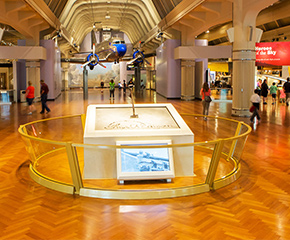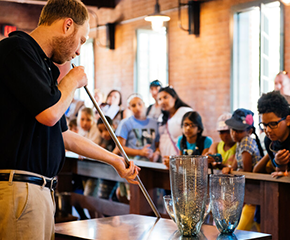
Detroit Central Market
Originally constructed in 1860 in downtown Detroit, the vegetable shed from the Detroit Central Market now stands fully reconstructed at Greenfield Village.
After a storied 160-plus-year history that included commerce, near-demolition and then reconstruction, the Detroit Central Market became the first historic structure added to Greenfield Village since 2000. Guests can engage with village presenters to learn more about the historic market's significance.
Countless stories await. Join us as we explore Detroit's historic public market, a local food environment that flourished for 30 years in downtown Detroit. This history sets a stage for ongoing conversations about how we can envision a more sustainable food future.
Detroit Central Market Weekends
Explore Detroit's historic public market as it comes to life with local vendors, including farmers, artisans and makers, during our Detroit Central Market Weekends. Enjoy chef demonstrations and special programming as you mingle with vendors during market hours from 10:00 a.m.-4:00 p.m.
- June 8-9
- July 13-14
- August 17-18
- September 28-29
Vendors at Detroit Central Market Weekends*
*Vendors may change throughout Detroit Central Market Weekends.
Music in the Market
A new performance series brings music history to the market where guests will discover many styles of talent by local performing artists, including instrumentalists, vocalists, dancers and playwrights. Please visit the Music in the Market page throughout the village season for updates and information on our next program.
Access to Detroit Central Market Weekends and Music in the Market is included with village admission and free for members.
Building History
In 1860, the City of Detroit invested in a new permanent building for the Detroit Central Market to house vendors in the open-air market behind City Hall; the new building was referred to as the vegetable building or shed. From 1861 to 1893, farmers, market gardeners, florists and nurserymen sold their produce in this building from rented stalls, marking over 30 years of commerce in its original environment.
The new building captured the exuberance and optimism of Detroit as it grew from a frontier fort and outpost to an important cultural and industry-rich city. A "useful and beautiful" market building in the city's central square was important in framing this image. Few buildings survive from this first era of Detroit's growth. This one survived because city officials moved it out of the city center, thus preserving a rare 19th-century market structure.
In 1894, Detroit's Parks & Boulevards commission moved the market shed to Belle Isle, where it remained for 110 years and served a variety of purposes, including a vehicle and horse shelter, riding stable and more. Although the shed served as a monument to public life, it was scheduled to be demolished before The Henry Ford acquired it in 2003.
The Henry Ford purchased the building, dismantled it and moved it from Belle Isle into storage. Fundraising, research and development, and building preservation continued until 2020 when reconstruction officially began in Greenfield Village.
The Detroit Central Market project sheds light on how museums collect, preserve and interpret history, illustrating how a more than 160-year-old structure can be recast to serve the next generation.
Keep Up with the Latest Stories on Our Blog
Learn more about the history of Detroit Central Market, plus new ways we’re bringing stories of edible education to life, on our blog.
Submit Your Stories
Have historical stories at the Detroit Central Market you'd like to share? Contact us at ask@thehenryford.libanswers.com.
Become a Donor
Interested in joining the Carver-Carson Society? Click HERE to learn more.



